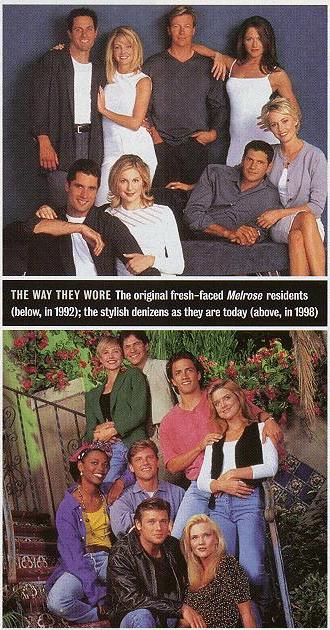
Saving 'Place'
Competition from Ally and Buffy had declawed Spelling's vixens. Can a seventh-season makeover put the bite back in Melrose ratings? by Dan Snierson
Like any soap worth its salt, Melrose Place excels at the loopy plot twist and Omigod cliff-hanger: Alison leaves Billy at the altar! Sydney turns to prostitution to pay the bills! Kimberly blows up a building!
But for its seventh season, Fox's festival of backstabbing may have pulled off the most shocking stunt of all. It's still on!
That's right, the guiltiest pleasure of '90s TV is back, and facing a challenge its callow characters can certainly relate to: how to reverse signs of aging. After bitchslapping its way through the first half of the decade as the watercooler show for 18- to 34-year-olds, Melrose lost its punch. A whopping 24 percent of viewers have vanished since 1995-96, prompting some to wonder, Why bother slipping between the sheets again? Was it high-note syndrome--the desire to send the series off with one final boffo season? Definitely not, insists exec producer Charles Pratt: "It's the first year of the new Melrose. We have fans just waiting to give us another chance. We have nothing to lose."
 Except precious Nielsen points. In its zenithal '93-94 season, the steamy soap averaged nearly 14 million viewers a week, with the finale nabbing 19.3 million; last year, it averaged about 10 million. The producers point to a time-slot move four years ago--from Wednesday at 9 to its current family-hour nest on Monday at 8--and concede that fans have been subjected to a steady stream of cast departures (many actors blamed burnout). Those exits forced the show to stock up on so much new blood, it could've been sponsored by the Red Cross. "With 13 characters and eight story lines" per episode, notes original cast member Josie Bissett (Jane Mancini), back on the show after quitting in '96, "I'd be left going 'Okay...what just happened?' " Except precious Nielsen points. In its zenithal '93-94 season, the steamy soap averaged nearly 14 million viewers a week, with the finale nabbing 19.3 million; last year, it averaged about 10 million. The producers point to a time-slot move four years ago--from Wednesday at 9 to its current family-hour nest on Monday at 8--and concede that fans have been subjected to a steady stream of cast departures (many actors blamed burnout). Those exits forced the show to stock up on so much new blood, it could've been sponsored by the Red Cross. "With 13 characters and eight story lines" per episode, notes original cast member Josie Bissett (Jane Mancini), back on the show after quitting in '96, "I'd be left going 'Okay...what just happened?' "
She wasn't the only one. Perhaps encouraged by a favorable response, plots grew increasingly inane (e.g., a wedding day hit-and-run). "Even with the best intentions, the show had almost become a parody of itself," admits Fox Entertainment president Peter Roth. Furthermore, the burst of competition from campy female-fronted dramedies like Buffy the Vampire Slayer and Ally McBeal made Melrose look silly and stale. "People talk about loving Ally's strong characters and relatable stories told in a new way," sighs Pratt. "They said the same about us in year two."
What went wrong? In the writers' room--as well as on the set--malaise had set in. According to Jack Wagner (Dr. Peter Burns), "There was some lackadaisical acting. We didn't have that creative juice you need on set." Adds Pratt: "I remember plotting something at a group meeting last season and everybody said, 'Yeah, yeah, sounds good.' I thought, What happened to the days when we'd go through 135 options for ending an act?"
Cranking out 30-plus episodes a year (the network average is 22) might have something to do with it. "We're celebrating our 200th episode [Sept. 14]; for most series, that's like 10 years," notes exec producer Aaron Spelling, who, with Melrose and Beverly Hills 90210, has two of the three longest-running dramas now in prime time. "I never thought we'd make it to a seventh season."
If he sounds exhausted, imagine how the writers feel: Exec producer Carol Mendelsohn, one of the show's six scribes, bemoans digging up fresh bitchery for Heather Locklear's Amanda Woodward--not to mention new diseases. "We already had people with paralysis, blindness, fake rage epilepsy--which I didn't even know existed." Thus, this season's revival of old-school strategies: fewer crime-driven or otherwise ludicrous story lines; the return of Jane ("I told them I'd come back if I wasn't a bitch or crazy," says Bissett); and a smaller core cast, reminiscent of Melrose's early seasons. "We're focusing on relationships again," says Pratt, "taking it out of helicopter crashes and putting it back into the bedroom." Plus, for the first time since '92, the writers and actors are walking through each script at table reads. "When you include actors" in the process, says Wagner, "it's going to pay off in the performances."
So far, however, it hasn't paid off in viewers. In its July 27 season debut, Melrose did win its time slot among 18- to 49-year-olds, which appeals to advertisers. But it drew just 7.5 million viewers (against summer reruns!) and hopes of those numbers building are slim. Only one maturing drama ever saw a major ratings rebirth: CBS' Gunsmoke spent seven seasons in the top 10 before sliding off the charts; but with a new time slot and some tweaking, it rocketed back into the top 10 for another five. "The soaps of the '80s [Dynasty, Dallas] tried renewal toward the end of their run, but none were successful," says USA Networks VP and noted tube historian Tim Brooks. And unlike a soap, he adds, "Gunsmoke didn't have very intricate, continuing story lines."
"The summer episodes and [rehiring] Josie is smart, but Melrose is fighting against the laws of gravity," agrees Whitey Chapin, a VP at ad-buying agency TN Media.
The days of an Amanda double cross making news-at-11 reels probably are over, but Fox's Roth still sees the future through Melrose-colored glasses--at least as long as the show continues to make money (Fox paid almost $70 million for 35 new episodes and expects to top that figure in ad revenue). "I'm convinced we have at least one more great year," he says. And hopefully it won't include this scenario: "I've been trying to wear Josie's dresses for a long time," hints Wagner. "C'mon, look at my legs. Shouldn't I have a little skirt scene?"
|

 Except precious Nielsen points. In its zenithal '93-94 season, the steamy soap averaged nearly 14 million viewers a week, with the finale nabbing 19.3 million; last year, it averaged about 10 million. The producers point to a time-slot move four years ago--from Wednesday at 9 to its current family-hour nest on Monday at 8--and concede that fans have been subjected to a steady stream of cast departures (many actors blamed burnout). Those exits forced the show to stock up on so much new blood, it could've been sponsored by the Red Cross. "With 13 characters and eight story lines" per episode, notes original cast member Josie Bissett (Jane Mancini), back on the show after quitting in '96, "I'd be left going 'Okay...what just happened?' "
Except precious Nielsen points. In its zenithal '93-94 season, the steamy soap averaged nearly 14 million viewers a week, with the finale nabbing 19.3 million; last year, it averaged about 10 million. The producers point to a time-slot move four years ago--from Wednesday at 9 to its current family-hour nest on Monday at 8--and concede that fans have been subjected to a steady stream of cast departures (many actors blamed burnout). Those exits forced the show to stock up on so much new blood, it could've been sponsored by the Red Cross. "With 13 characters and eight story lines" per episode, notes original cast member Josie Bissett (Jane Mancini), back on the show after quitting in '96, "I'd be left going 'Okay...what just happened?' "